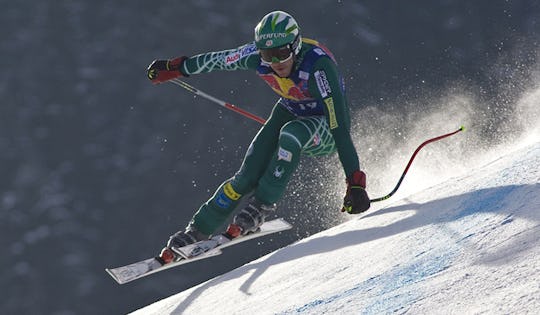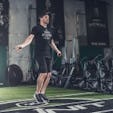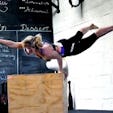A tremendous part of Bode Miller’s olympic skiing success is due to agility training. Growing up in Austria, a country dominated by winter sports, every athlete was trying to mirror the workout routine used by the olympic skiing competitors. Skiers have always placed training value on balance and conventional strength and they still do to this day; a perfect example demonstrating this is Bode Miller.
Bode Miller is one of the most decorated alpine skier’s in the world. He has a way of skiing that impresses the spectators, doing things others can’t even imagine. Due to his unorthodox skiing style, he puts himself in the most turbulent and dangerous situations on the slopes, showing off his phenomenal coordination, balance, and agility as a whole.
Thanks to his unconventional approach showcasing full balance and speed, he was able to win the Olympic Gold Medal. Bode grew up in the woods, where certain agility movements developed the coordination which looks so natural today. The development of these skills at such a young age are crucial to Bode Miller’s professional success we see today.
What is Agility Training?
Agility comes from the latin word agilis (“nimble, fleet, quick”) and is defined as the body’s ability to move quickly and gracefully. In order to move as swiftly as possible, certain individual physical components need to be established first. Developing functional balance, coordination, speed, reflexes, strength, and endurance is the easy part; what separates the good from the elite is the ability to transfer these skills to whatever your competitive playing field is.
Agility Training Should be Developed at a Young Age
Balance, coordination, quick feet, fast reaction time, power, and endurance are mandatory training focal points for any sport to start off with. We already know that our brain develops, evolves, and learns much quicker in the early years of childhood. Therefore, it is imperative for children to develop these components between the ages of 4 and 12 years of age, no matter what sport they love to compete in. It is possible to develop these skills as an adult but you will have a greater learning curve as opposed to an adolescent with a developing mind.
As a former tennis instructor, I taught adults as well as youths how to play tennis. As a warm up prior to playing tennis, I always utilized exercises related to coordination, balance, and agility for all ages. Believe it or not the exercises I used were equally as difficult for every client, despite the age. However, it was easy to differentiate which training adults had developed these skills as a child and those who had not.
Key #1: Acknowledge the Mind-Body Connection of Agility Training
The mind-body connection is an often overlooked attribute when discussing athletic activities which is a problem with the fitness community. It is no coincidence that agility develops during a young age. The mind-body connection with agility training is extremely important as agility may be the physical skill most difficult to develop.
Agility requires equal development of strength, balance, speed, and coordination. All competitors discuss the mental aspect of training and how it’s valued in sports training, but most athletes neglect to ever directly train and stimulate the mind. In order to properly do agility exercises, or any exercise, and get the most out of them, you must focus your mind to react entirely in the present moment. This explanation is similar to that of an athlete practicing visualization before a competition.
Key #2: Practice Agility with Perfect Form
Perfect form comes before anything else, no matter what you do. Start off slowly, doing exercises as close to perfect as possible. This comes before you think about speed or making the exercise more difficult. The right technique will ultimately make the difference. In order to do this, you need to get your mind right and focus prior to starting your agility reps. As you begin to progress with each exercise, the mind-body connection will grow stronger, allowing you to move through your progression at an effortless fluid pace.
Key #3: Add Agility Training into Your Program
There are certain basic agility exercises that every coach, trainer, and instructor should include in their training session warm up. Running ladders or jump rope, hand eye coordination utilizing a ball, balance exercises, and change of direction drills all give the perfect blend of tools to raise your internal body temperature, lube your joints, and help prevent any injuries from occurring.
Here is a sample warm-up you could use prior to an intense sport competition or a leisurely physical activity.
Rope Ladder Warm Up:
A1. One foot each hole x 2
A2. Two feet each hole x 2
A3. Side shuffle x 2
A4. “Ickey” shuffle x 2
A5. One leg hops x 2
A6. Ankle flips x 2
A7. One leg hops down & back x 2
A8. Ankle flips down & back x 2
A9. In & Out shuffle x 2
A10. In & Out shuffle down & back x 2
If you do not have access to a rope ladder you could perform a warm up using a jump rope to help develop agility and lower body awareness.
Dynamic Warm Up
A1. Jumping Jacks x 10
A2. Seal Jacks x 10
A3. Squats x 10
A4. Walking Lunges with Torso Twist x 5 (each leg)
A5. Side Lunges x 5 each leg
A6. Push ups x 10
A7. Prone Scorpions x 10 (each leg)
A8. Supine Scorpions x 10 (each leg)
A9. Supine Leg Raises x 10 (each leg)
A10. Inchworms x 5

)





